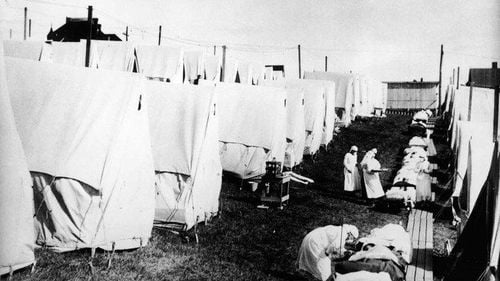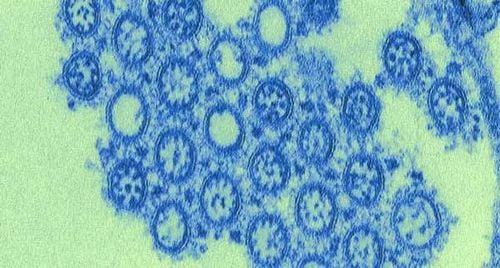This is an automatically translated article.
Pandemic influenza is a global outbreak of a new influenza A virus, very different from the current and recent seasonal influenza A viruses circulating in humans. Influenza viruses are constantly changing, making it very rare for non-human influenza viruses to change their routes of transmission and be able to infect people easily. At the same time, the virus can spread from person to person. This article helps you learn more about the terrible pandemics that the world has experienced.
1. What is pandemic influenza?
Pandemic influenza is a pandemic caused by influenza viruses that spread worldwide and infect a large proportion of the world's population. In contrast to regular seasonal flu outbreaks, these pandemics occur irregularly. Pandemic can cause high mortality. For example, the worst flu pandemic in recorded history was Spain in 1918. This pandemic is estimated to have caused a high mortality rate of 50 to 100 million people. There have been about three influenza pandemics per century in the past 300 years, most recently the 2009 flu pandemic.
Pandemic influenza occurs when a new strain of influenza virus is transmitted to humans from another animal species. Species thought to be important in the emergence of new virus strains are pigs, chickens and ducks. These new strains are not affected by any immunocompromised people who have been infected with the old flu strains. Therefore, it can spread extremely quickly and spread to a lot of people.
Influenza A can sometimes be transmitted from wild birds to other species causing outbreaks in poultry and possibly causing pandemic influenza in humans. The worldwide spread of influenza viruses is thought to be part of bird migration or travel patterns.
Trắc nghiệm: Bạn có phân biệt được chính xác cảm lạnh và cúm mùa?
Cảm cúm và cảm lạnh là hai khái niệm mà chúng ta thường đánh đồng nó giống nhau, không phân biệt rõ ràng. Dưới đây là một số câu hỏi trắc nghiệm, giúp bạn có thêm những kiến thức phân biệt cảm lạnh và cảm cúm. Từ đó, có những biện pháp điều trị bệnh phù hợp.2. Pandemics in the world
2.1. Influenza pandemic of 1918 The influenza pandemic of 1918 was the most severe pandemic in history. It is caused by a virus A (H1N1) of avian origin. Although there is no universal consensus on the origin of the virus, it spread worldwide between 1918 -1919. In the United States, the virus was first identified in a soldier in the spring of 1918.
It is estimated that approximately 500 million people or one-third of the world's population have been infected with this virus. The death toll is estimated to be at least 50 million worldwide with about 675,000 occurring in the United States. Mortality rates are high among those under 5 years old, between 20 and 40 years old and over 65 years old. At the same time, mortality is high in healthy people, including those between the ages of 20 and 40. And this is a salient feature of this pandemic.
Although the 1918 influenza virus has been synthesized and evaluated, the properties that make it so devastating are still poorly understood. There is no vaccine to protect against influenza infection, and no antibiotics to treat secondary bacterial infections that may be related to influenza infection. Control efforts worldwide are limited to non-pharmaceutical interventions such as isolation, good personal hygiene, use of disinfectants, and restrictions on public gatherings. However, the measures are applied unevenly.
The 1918 influenza pandemic, commonly known as the Spanish flu, was a type 5 influenza pandemic caused by a strain of influenza A virus that causes severe and fatal influenza.

Đại dịch cúm năm 1918
2.2. 1957-1958 pandemic (H2N2 virus) In February 1957, a new influenza A (H2N2) virus emerged in East Asia, causing the Asian influenza pandemic. This H2N2 influenza virus consists of three different genes from the H2N2 virus derived from influenza A viruses and includes both the H2 hemagglutinin and the N2 neuraminidase gene. It was first reported in Singapore in February 1957, Hong Kong in April 1957, and in coastal cities in the United States in the summer of 1957. The estimated death toll was 1.1 million worldwide. world and 116,000 people in the United States.
2.3. The 1968 pandemic (H3N2 virus) The 1968 pandemic caused by influenza A virus (H3N2) consisted of two genes from the influenza A virus including a new hemagglutinin H3 gene and an N2 neuraminidase gene from the 1957 H2N2 virus. First recorded in the United States in September 1968. The estimated death toll is 1 million worldwide and about 100,000 in the United States. Most of the deaths are in people over the age of 65.
The H3N2 virus circulates worldwide as a seasonal influenza A virus. The H3N2 virus is seasonal, is associated with severe disease in older adults, and undergoes frequent antigenic variation.

Đại dịch năm 1968 (virus H3N2)
2.4. 2009 Flu Pandemic - A New Influenza Virus Emerging Influenza A (H1N1) pdm09 virus is very different from the H1N1 circulating at the time of the pandemic. Very few young people have any pre-existing immunity (detected by an antibody response) to influenza A (H1N1) virus pdm09, but nearly a third of people over 60 years of age have antibodies against this virus. but there is still the possibility of being exposed to the older virus than before.
Because influenza A (H1N1) pdm09 virus is very different from circulating influenza viruses, seasonal influenza vaccination provides little protection against influenza A (H1N1) pdm09 virus. Although the influenza A (H1N1) pdm09 virus vaccine was produced, it was not available in large quantities until late November, after the peak of the epidemic in the second wave to and from the United States. As of April 12, 2009, the Centers for Disease Control and Prevention (CDC) estimated there were 60.8 million infections (range 43.3 - 89.3 million), 274,304 hospitalizations (range 195,086 - 402,719), and 12,469 deaths (range 8,868 - 18,306) in US states due to influenza A (H1N1) virus pdm09.
Additionally, the Centers for Disease Control and Prevention estimates that 151,700 - 575,400 people worldwide died from influenza A (H1N1) pdm09 virus in the first year the virus circulated. Globally, 80% of influenza A (H1N1) pdm09 virus-related deaths are estimated to occur in people younger than 65 years of age. This is vastly different from typical seasonal flu epidemics, in which between 70 and 90 percent of deaths are estimated to occur in people 65 years of age or older.

Virus cúm A (H1N1) pdm09
Although the 2009 flu pandemic mainly affected children, young adults and middle-aged adults. However, the impact of influenza A (H1N1) virus pdm09 on the global population during the first year was less severe than in previous pandemics. Estimates of mortality from pandemic influenza range from 0.03% of the world's population, during the H3N2 pandemic of 1968 up to 1% of the world's population and 3% of the world's population during the 1918 flu pandemic.
It has been estimated that between 0.001 and 0.007% of the world's population die from respiratory complications related to infection with influenza A (H1N1) virus pdm09 during the first 12 months of viral circulation.
Reference: cdc.gov
MORE:
All you need to know about seasonal flu Different types of flu: Influenza A, B, C and others WHO recommendations for seasonal flu













